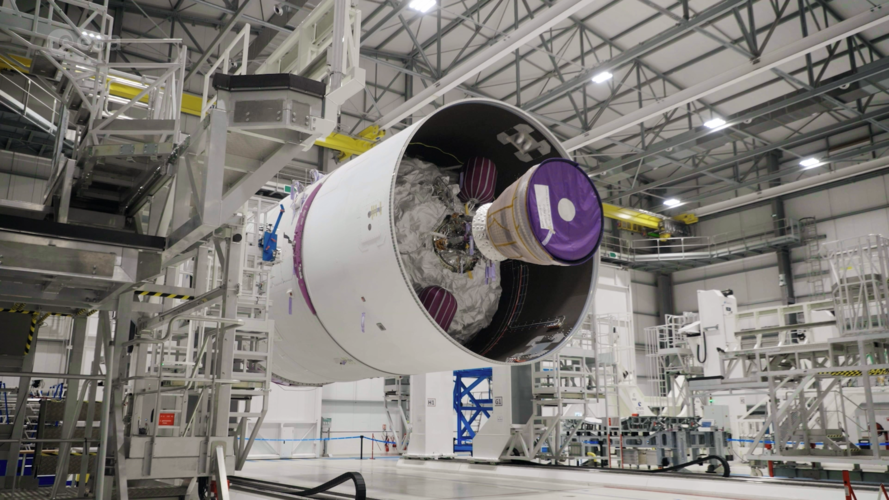
Copernical Team
AI-enabled atomic robotic probe to advance quantum material manufacturing
 Scientists from the National University of Singapore (NUS) have pioneered a new methodology of fabricating carbon-based quantum materials at the atomic scale by integrating scanning probe microscopy techniques and deep neural networks. This breakthrough highlights the potential of implementing artificial intelligence (AI) at the sub-angstrom scale for enhanced control over atomic manufacturing,
Scientists from the National University of Singapore (NUS) have pioneered a new methodology of fabricating carbon-based quantum materials at the atomic scale by integrating scanning probe microscopy techniques and deep neural networks. This breakthrough highlights the potential of implementing artificial intelligence (AI) at the sub-angstrom scale for enhanced control over atomic manufacturing, BlackSky Secures Major Contract to Advance DoD's Moving Target Analysis
 In a significant development for defense technology and space-based surveillance, BlackSky Technology Inc. (NYSE: BKSY) has been awarded a multi-million dollar contract by the U.S. Department of Defense. This collaboration marks a pivotal step forward in the utilization of commercial motion imagery to train artificial intelligence models for tracking moving targets.
Under this contract, Bl
In a significant development for defense technology and space-based surveillance, BlackSky Technology Inc. (NYSE: BKSY) has been awarded a multi-million dollar contract by the U.S. Department of Defense. This collaboration marks a pivotal step forward in the utilization of commercial motion imagery to train artificial intelligence models for tracking moving targets.
Under this contract, Bl BAE Systems and EDF launch MethaneSAT to revolutionize global methane emissions monitoring
 BAE Systems (LON: BA) and the Environmental Defense Fund (EDF) have successfully launched MethaneSAT, a cutting-edge satellite designed to provide unprecedented insights into methane emissions across the globe. The launch, which took place at Vandenberg Space Force Base in California, marks a significant step forward in the fight against climate change, leveraging advanced satellite technology t
BAE Systems (LON: BA) and the Environmental Defense Fund (EDF) have successfully launched MethaneSAT, a cutting-edge satellite designed to provide unprecedented insights into methane emissions across the globe. The launch, which took place at Vandenberg Space Force Base in California, marks a significant step forward in the fight against climate change, leveraging advanced satellite technology t As Russian Threats Grow, King Warns U.S. Space Command of American Vulnerabilities
 In a move to address vulnerabilities in America's space infrastructure, U.S. Senator Angus King (Ind. ME) has emphasized the urgency of bolstering defenses against potential threats to the nation's extensive satellite fleet. During a Senate Armed Services Committee hearing, Senator King engaged with General Stephen Whiting, the Commander of the United States Space Command (USSPACECOM), on the cr
In a move to address vulnerabilities in America's space infrastructure, U.S. Senator Angus King (Ind. ME) has emphasized the urgency of bolstering defenses against potential threats to the nation's extensive satellite fleet. During a Senate Armed Services Committee hearing, Senator King engaged with General Stephen Whiting, the Commander of the United States Space Command (USSPACECOM), on the cr Hera asteroid mission vs. absolutely nothing
 Image:
Hera asteroid mission vs. absolutely nothing
Image:
Hera asteroid mission vs. absolutely nothing Ariane 6 stages having a BAL
 Video:
00:01:44
Video:
00:01:44
The two central stages for Ariane 6’s first flight are being assembled in the launcher assembly building (BAL) at Europe’s Spaceport. The core stage and the upper stage for Europe’s new rocket Ariane 6 are set to fly in the Summer of 2024. Once assembled, the stages will be transferred to the launch pad.
On the launch pad, the two stages will be raised into their vertical launch position inside the mobile assembly building. Here the two boosters for Ariane 6’s first flight will be added and then the payloads will be placed on top and be covered
New NASA astronauts graduate, eying Moon -- and Mars
 After two years of rigorous training, ten Americans officially became astronauts on Tuesday, and are now eligible for planned NASA missions to the International Space Station, the Moon, and - if all goes well - to Mars.
Two Emiratis who trained alongside them also graduated Tuesday during a ceremony at the Johnson Space Center in Houston.
Members of the class, nicknamed "The Flies," we
After two years of rigorous training, ten Americans officially became astronauts on Tuesday, and are now eligible for planned NASA missions to the International Space Station, the Moon, and - if all goes well - to Mars.
Two Emiratis who trained alongside them also graduated Tuesday during a ceremony at the Johnson Space Center in Houston.
Members of the class, nicknamed "The Flies," we Just add AI for expert astronaut ultrasound

Ultrasound devices are commonplace in modern orbital medical kits, helping to facilitate rapid diagnoses of astronaut ailments or bodily changes. However it takes real-time guidance from experts on the ground to acquire medically useful ultrasound images. Once astronauts travel to the Moon or further into the Solar System such guidance will no longer be practical due to the time delay involved. A new ESA-led project aims to leverage AI and Machine Learning so that astronauts can perform close to expert quality ultrasound exams by themselves.
Space tourists need better warnings about cosmic radiation exposure, say experts

Space weather experts at the University of Surrey are urging regulators and space tourism innovators to work together to protect their passengers and crews from the risks of space weather radiation exposure.
The Earth's atmosphere and magnetic field protect people on the ground from exposure to unpredictable surges of electrically charged particles coming from the sun. However, there can be dramatic increases in potential radiation exposure at higher altitudes, such as those envisaged for space tourist flights.
Space weather cannot yet be predicted and can lead to health risks such as damage to DNA, and it could lead to cancer. Despite this, space tourists currently receive little information and few warnings.
Chris Rees, lead author of a new paper on radiation risks to space tourism and a postgraduate researcher at Surrey Space Center, said, "Although space tourism is very niche, it will quickly grow as an industry.
Astronauts arrive at International Space Station for swap

Three US astronauts and a Russian cosmonaut arrived Tuesday at the International Space Station for a six-month mission on board the orbiting laboratory.
During their stay, in which they are rotating in to replace departing crew, some 200 scientific experiments are scheduled to be carried out.
The quartet blasted off from Florida late Sunday aboard a SpaceX Falcon 9 rocket.
The capsule docked with the ISS and its hatch was opened at 3:50 am Tuesday US eastern time (0850 GMT), with the smiling new arrivals hugging their colleagues as they entered, a live feed of the docking showed.
This is the eighth standard ISS crew rotation mission performed by SpaceX for the US space agency NASA, reflected in the mission name: Crew-8.
American Michael Barratt is the only Crew-8 astronaut to have already visited the space station. The ISS stay is the first for Americans Matthew Dominick and Jeanette Epps, and Russian Alexander Grebenkin.
They join seven crew already on board the ISS.
After a transition period of a few days, the four members of Crew-7—from Denmark, Japan, Russia and the United States—will return to Earth aboard another SpaceX capsule.

